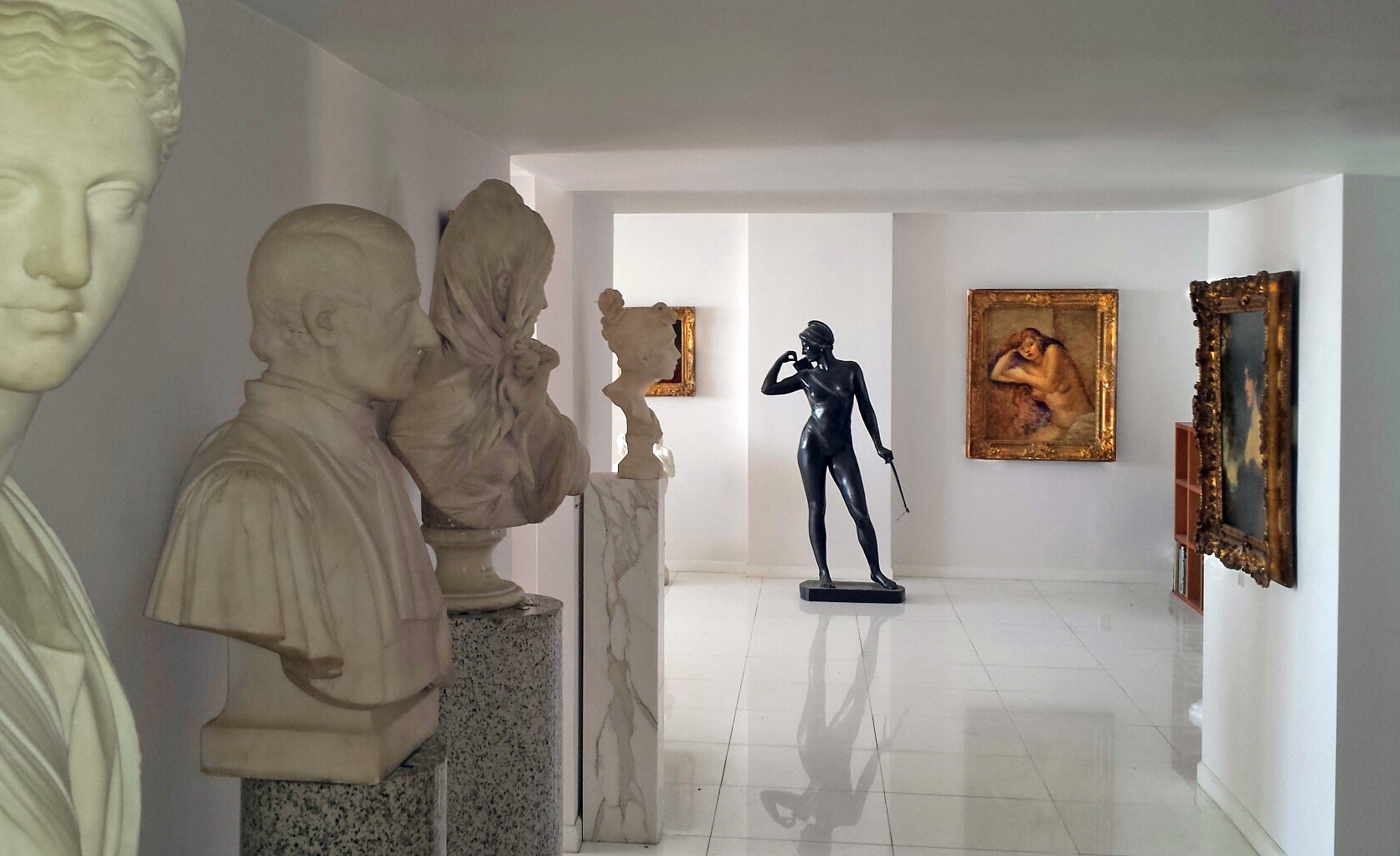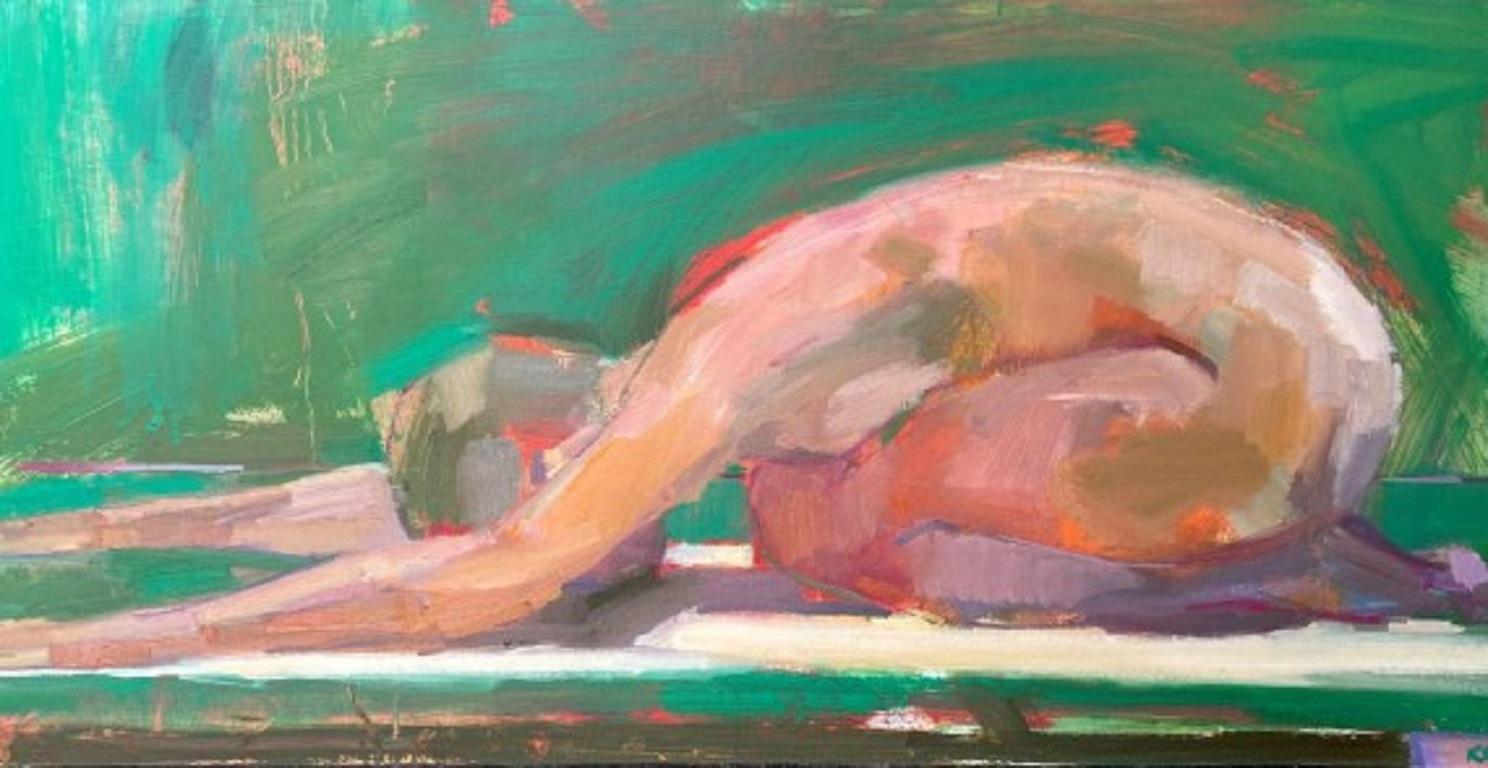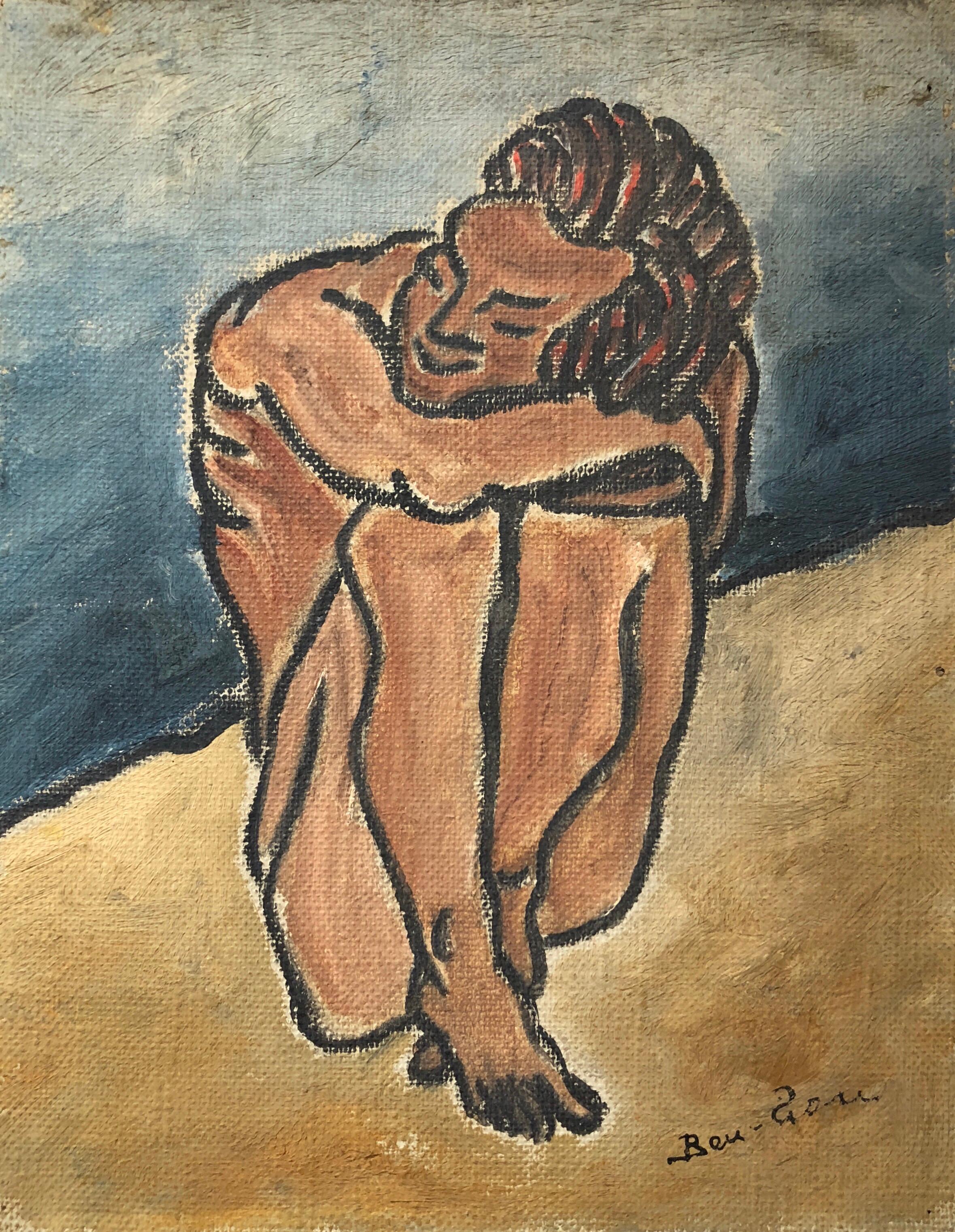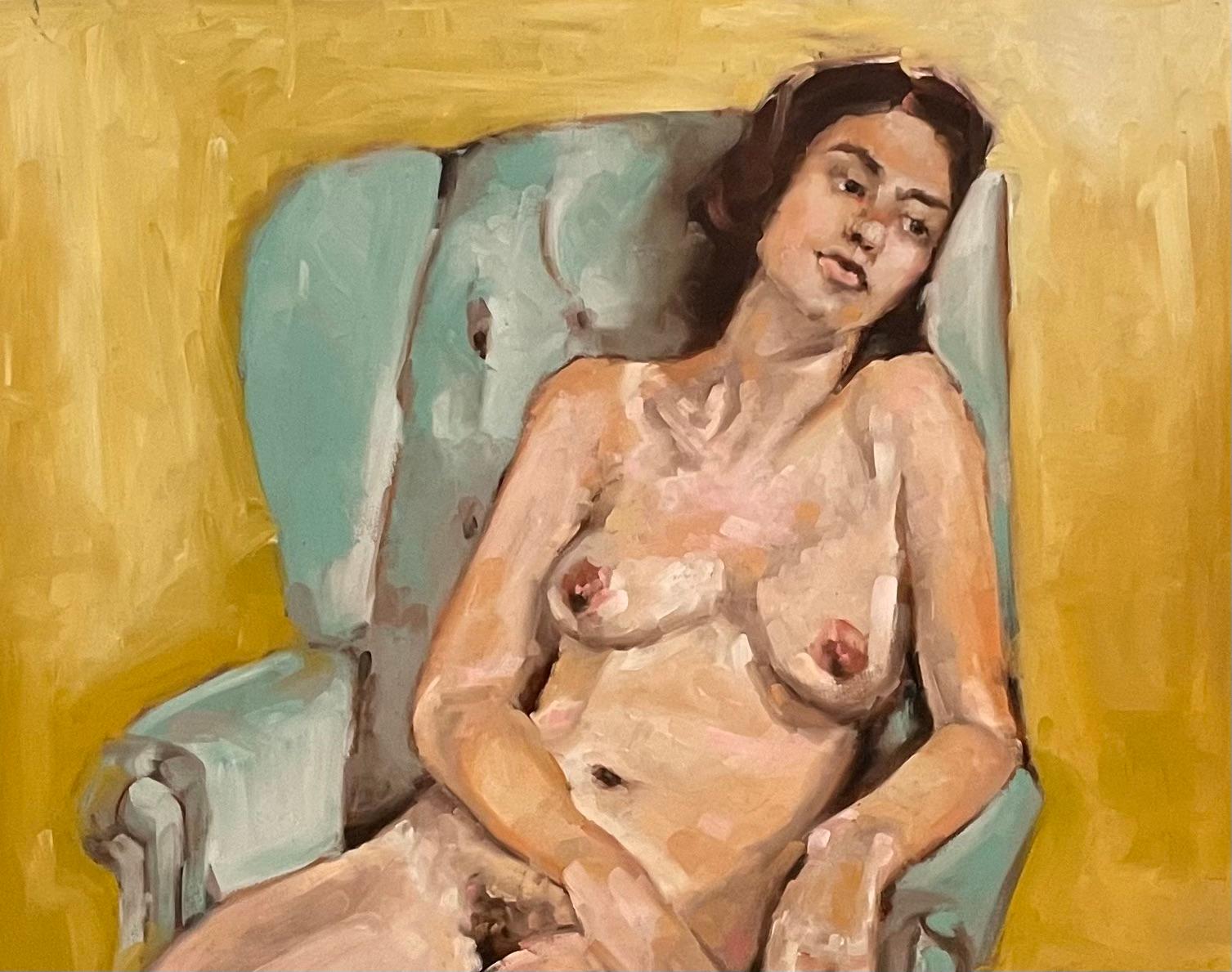Items Similar to Nude Dancer Burlesque Stripper with Purple Gloves - The Bump -
Want more images or videos?
Request additional images or videos from the seller
1 of 21
Jack LevineNude Dancer Burlesque Stripper with Purple Gloves - The Bump - 1979
1979
About the Item
A gritty Burlesque Stripper with long purple gloves bumps and grinds with a hard-driving beat. American Social Realist artist Jack Levine paints this sensuous nude with in an expressionist style with quick bravura brushstrokes and fast-moving black outlines. Signed lower left. Provenance: Kennedy Galleries, Doyle
Levine once said of himself, "I am primarily concerned with the condition of man." Following his own direction, he created a distinct body of socially conscious art that probes the strengths and weaknesses of humanity. Wear along the edges with some losses along the bottom center edge and, with losses to the corners; small area of craquelure in the woman's upper left arm; back of each corner with attached board support. No further apparent restoration. Mostly visible on close inspection only, otherwise presents very well in person with rich saturated colors and bravura brush strokes
- Creator:Jack Levine (1915, American)
- Creation Year:1979
- Dimensions:Height: 29.5 in (74.93 cm)Width: 21.5 in (54.61 cm)
- Medium:
- Movement & Style:
- Period:
- Condition:Overall good condition Wear along the edges with some losses along the bottom center edge and, with losses to the corners; small area of craquelure in the woman's upper left arm; back of each corner with attached board support.
- Gallery Location:Miami, FL
- Reference Number:1stDibs: LU38539541992

About the Seller
4.9
Platinum Seller
These expertly vetted sellers are 1stDibs' most experienced sellers and are rated highest by our customers.
Established in 2005
1stDibs seller since 2016
102 sales on 1stDibs
Typical response time: 1 hour
- ShippingRetrieving quote...Ships From: Miami, FL
- Return PolicyA return for this item may be initiated within 3 days of delivery.
More From This SellerView All
- Sexy Woman in a Swamp Storm - Pulp Magazine, Hispanic Artist, Mid CenturyBy Rafael DeSotoLocated in Miami, FLRafael Maria de Soto y Hernandez was born February 18, 1904 in Aguadilla, Puerto Rico. It's high drama in the swamp. Woman in the Swamp is a masterfully executed example of Pulp Art and showcases Rafael DeSoto's full command of academic painting. DeSoto did pulp covers up until the industry's demise in the 1950s for such magazines as Adventure, Argosy, Black Mask, Captain Zero, Crack Detective, Fantastic Novels, 15-Story Detective, Fifteen Western Tales, New Detective, Smashing Detective, and Walt Coburn's Western Magazine. He also painted many covers and interior story illustrations for men's adventure magazines, such as Action For Men, Adventure, Battle Cry, For Men Only...Category
1950s Academic Figurative Paintings
MaterialsBoard, Oil
- Nude Boy Discovered in Barn - Gay InterestBy Norman Mills PriceLocated in Miami, FLNorman Mills Price depicts a handsome, nude blond boy with classical good looks. He is lying on his stomach in straw in the loft of a barn with his buttocks exposed. The artist captu...Category
1910s Academic Nude Paintings
MaterialsGouache, Pencil, Board
- What Are They Looking At ? Sexy Nude Naive Caribbean Art , Swimming Pool PartyBy Wilson BigaudLocated in Miami, FLA young man at a crowded upper-class Haitian swimming pool attracts attention. We see him only from the back in a Magritte like pose. Transfixed expressions of some of the nubile bare-breasted bathing beauties and one man with his hands down his pants give us a clue that the mystery man is special. This is a fascinating work packed with drama and overflowing with pent-up emotion. Bigaud's narrative is as complex as his figural composition of lookers and swimmers. Notice the sight lines of the lookers go back to front while the two swimmers go from left to right. The twenty-two figures are contained in the rectangular shape of the pool, which is pushed to the front of the picture plane. The cars of the pool partygoers are seen in the background with one witness. He is fully clothed and is most likely a chauffeur. The fully clothed female at the pool offering food is a servant. A boxy-looking radio with a pack of cigarettes and the style of the cars give glue to the date. Most Haitian art depicts average working people. The pool party departs from that tradition and shows life of the Haitian upper class. Most likely, this was painted in Petion-Ville. The higher the elevation in Port-au-Prince the more wealthy the homes. Although the artist's painting technique may be described as naive or lacking polish. It's one of the reasons why the work radiates charm and interest. The painting is oversized with huge dimensions of 55 x 48 and will be a statement in any room. Wilson Bigaud is considered to be a Haitian master. The condition is good. Three repaired one-inch issues on the extreme center and upper right edge. Visible only on close inspection. Otherwise presents very well and is elegantly framed, ______________________________________ Haitian master Wilson Bigaud is renowned for works portraying everyday life and rites of passage—vodou rituals, fortune-tellers, weddings, cockfights, and carnivals—with voluminous figures and lucid colors. Born in Port-au-Prince, in 1946 Bigaud was among the first to attend DeWitt Peters’s Le Centre d’Art d’Haïti, where he studied with Hector Hyppolite...Category
1970s Outsider Art Figurative Paintings
MaterialsMasonite, Oil
- Elegant Nude Woman in Dancing - Mid-Century MonochromaticBy Walter Charles KlettLocated in Miami, FLExcellent Mid-century nude by famous illustrator/ artist Walter Charles Klett. The work is masterfully painted with a sound understanding of the basic academic principles guiding t...Category
Mid-20th Century American Realist Nude Paintings
MaterialsOil, Masonite
- Nude on ChairBy Max WeberLocated in Miami, FLHeavy impasto pained in alla prima ( Wet-on-wet ) technique. Layer of damar varnish. Frame burn, On Masonite. Unframed Signature: Signed Max Weber upper left.Category
1940s Cubist Figurative Paintings
MaterialsOil
- Nude Girl, Polynesian Girl Tahiti, AnnabellaBy Millard SheetsLocated in Miami, FLIn some instances, a painting will look significantly much better in person than it does digitize. This is one instance. In-person, this painting will knock your socks off. It is...Category
1940s Post-Impressionist Nude Paintings
MaterialsOil, Canvas
You May Also Like
- "Nymphs" two voluptuous female nudes, gestural abstracted figures, clear colorsBy Tom BennettLocated in Brooklyn, NYoil painting on board, an expressionist figurative homage to the work Diana and her Nymphs, by Rubens. Active, direct brushwork, flesh tonesCategory
2010s Expressionist Figurative Paintings
MaterialsOil, Board
- Rosie Copeland, Child's Pose (After the Wave) , Original Nude PaintingBy Rosie CopelandLocated in Deddington, GBRosie Copeland Child’s Pose (after The Wave) Original Nude Painting Medium – Oil on board Board Size: H 38cm x W 76cm x D 0.5cm Sold Unframed Please note that in situ images are pure...Category
21st Century and Contemporary Expressionist Figurative Paintings
MaterialsOil, Board
- Ecstatic Fatigue, abstracted female figure, nudeBy Tom BennettLocated in Brooklyn, NYOil on board. Abstracted, expressionist, figurative. Cool and warm greys with heightened color.Category
2010s Expressionist Figurative Paintings
MaterialsOil, Board
- Nandor Vagh Weinmann, Oil on cardboard, Naked Back, 1930sLocated in Saint Amans des cots, FROil on cardboard by Nandor VAGH WEINMANN (1897-1978), France, 1930s. Naked back. With frame: 64x56 cm - 25.2x22 inches ; without frame: 46x38cm - 18.1x15 inches. 8F format. Signed "Nandor V. Weinmann" lower left. In its Montparnasse frame. Very good condition. Born October 3, 1897 in Budapest, Nándor is the older brother of Elemer and Maurice Vagh-Weinmann. He came to Paris to present his work in 1931. He died on December 12, 1978 near Montereau (Seine-et-Marne) following an automobile accident. He is the most colorful of the three “expressionist” brothers. Painter of figures, landscapes, especially open mountains, and bouquets in bright colors. He is also a religious painter and then finds the tragic condition. Born in BUDAPEST on October 3, 1897, Nandor Vagh Weinmann belongs to a profoundly artistic people. Living in the heart of Central Europe where they came from Asia a millennium ago, the Hungarians have preserved a strong ethnic individuality whose mark is their very synthetic, non-Indo-European language. Resistant to secular invasions, they have kept the virtues of a very ancient humanity that have become rare in our modern world, especially since their way of life has remained essentially rural until today. In the arts they know how to express a generous, extreme sensibility and by the poetic verb, by the musical rhythms and also by a popular art of a richness, an exceptional harmony. Until the age of thirty-four, during the decisive years of childhood and youth, Nandor Vagh Weinmann was intimately imbued with popular life and the soul of Hungary. From the capital where his father was a jeweler and had a family of ten children, Nandor was the fifth, he knew first of all the suburbs, the populated districts, the rigors in winter of the cold and the snow. A very mobile existence made him acquainted with all of Hungary, from the Danube to Transylvania, its infinite plains and its wild mountains, its immense villages with ample low houses, and its towns which are still immense villages. The painter is passionate about rustic works, harvest scenes, beautiful folk costumes. Coming into direct contact with the peasants, he learned to know their soul. These contacts gave the artist a direct feeling for popular life and soul, as Millet once understood the peasants of Barbizon and Normandy whose existence he shared. What fascinated Nandor Vagh Weinmann above all were the festivals which enlivened the dreary life of the countryside, the circuses, the merry-go-rounds, the gypsies unleashing orgies of music, light and color. In the party, and especially the Hungarian party, the whole soul of a people, all its energy, its need for movement, for intensity, is expressed in its pure state and realizes the primary and essential form of what is called beauty. And as if melted at the party, there is the infinite steppe where herds of horses and oxen circulate where terrible storms sometimes roar where the seasons unfold their grandiose splendours. The young Nandor Vagh Weinmann nourishes his sensitivity to his inexhaustible shows, both eternal and always new, a sensitivity which very early declared itself that of a painter. Since the age of fourteen he painted, and since then he never stopped doing it. Two of his brothers Maurice, two years his junior, who had a remarkable career similar to that of Nandor and later Elemer who became Maurice's pupil, also devoted themselves to painting, despite family obstacles. And the three brothers united by a common passion worked together in Hungary and later in France. Painting was so much in the blood of the family, as in the past among the Veroneses, the Breughels, the Lenains, the Van Loos and so many other artistic dynasties, that three sons of the Vagh Weinmanns became painters in their turn. One of these, Emeric, son of Nandor, today occupies an important place in the contemporary school. Nandor, at fifteen, was a pupil of the Academy of Fine Arts in Budapest where he worked diligently, then at that of Vienna. He painted many portraits, but also landscapes, compositions and, by his relentless work, managed to live from his brush, although married very young and having to overcome many hardships. He therefore knew the hardships and miseries of life. These strongly impregnated his vision as an artist and explain the thrill of humanity that runs through all his work. A particularly moving experience was reserved for him at the age of twenty. In the hospitals of Budapest he had to paint extraordinary cases, operations, frightful wounds, the deformations to which our poor body is subjected by traumas and physiological decompositions. In these circumstances, it is not a question of gratuitous art, of formal research but of immediate, authentic expressions of our flesh and our being. We know that Breughel Velázquez and Goya had been haunted by the sight of cripples and of madmen Géricault by that of corpses. But life is ultimately stronger than anything, and it is life that Nandor Vagh Weinmann has passionately observed and translated through all the places where he has always painted on nature. Nothing stopped him. It happened to him to paint, for example in front of the mill of Linselles by a weather so cold, that nobody could stay outside, and that he did not leave the place before having finished his work. Because he works constantly on the ground, under the sky, in the silence he loves. His reputation is established. He exhibited at the national fair in Budapest, in the big cities of Hungary Szeged, Szombathely, Veszprém, Kaposvar. In 1931, like all artists in the world, he came to France. But unlike the others, he did not settle in Paris. Because Nandor Vagh Weinmann does not belong to this group of cosmopolitans that we call the School of Paris. He settled in Toulouse, where he remained for a long time with his brothers, and traveled throughout France, eager for new ties, exhibiting in the most diverse cities, in Bordeaux, Marseille, Lyon, Agen, Bayonne, Dax, Tarbes, Grenoble, Nice, Cannes, Strasbourg, Mulhouse, Colmar, Lille. He even crossed borders. He was in Saint Sebastian, in Geneva, and once in Egypt in 1927 where he painted King Fouad...Category
1930s Expressionist Figurative Paintings
MaterialsOil, Cardboard
- American Modernist Oil Painting Nude Male on Beach WPA Artist Group of 10By Ben-Zion WeinmanLocated in Surfside, FLBorn in 1897, Ben-Zion Weinman celebrated his European Jewish heritage in his visual works as a sculptor, painter, and printmaker. Influenced by Spinoza, Knut Hamsun, and Wladyslaw Reymont, as well as Hebrew literature, Ben-Zion wrote poetry and essays that, like his visual work, attempt to reveal the deep “connection between man and the divine, and between man and earth.” An emigrant from the Ukraine, he came to the US in 1920. He wrote fairy tales and poems in Hebrew under the name Benzion Weinman, but when he began painting he dropped his last name and hyphenated his first, saying an artist needed only one name. Ben-Zion was a founding member of “The Ten: An Independent Group” The Ten” a 1930’s avant-garde group, Painted on anything handy. Ben-Zion often used cabinet...Category
Mid-20th Century Expressionist Figurative Paintings
MaterialsOil, Board
- "Young Woman on Blue Chair" Contemporary Figurative Woman Nude by Shana WilsonBy Shana WilsonLocated in Carmel, CAShana Wilson's "Young Woman on Blue Chair" is a 16" x 20" (26.5x30.5 Framed) masterpiece that captures the essence of contentment and relaxation. The young nude woman, with brown hair and a tranquil expression, sits on a light blue chair against a backdrop of a warm, ochre-toned wall. Her posture, leaning to one side with one arm on the armrest and the other resting on her lap, exudes comfort. This framed artwork masterfully portrays a sense of calm and ease, inviting viewers to appreciate the serene moment it portrays. Wilson's attention to detail and use of color create a captivating and emotionally resonant composition. About the Artist: Over seven billion souls exist on this planet, each with a unique face and story. Shana transfers her visceral love for the human landscape to canvas, tenderly cradling its peaks and valleys, darkness and light, colors and neutrals, empty and full, hard edges and soft curves. Each brush stroke creates a controlled cacophony as it assembles the intricate jigsaw of the human face. An entire life’s journey is written on this human landscape; a journey that begs to be documented and treasured. Shana’s legacy project is to paint inspirational women from all walks of life, inclusive of all cultures and orientations. The subjects all have one thing in common; the ability to inspire and create social change. She pays tribute to them on canvas, painting a long overdue celebration of trail-blazing women. Visit any major gallery or museum in the world and it is teeming with paintings of nude women...Category
21st Century and Contemporary Expressionist Nude Paintings
MaterialsMixed Media, Board




